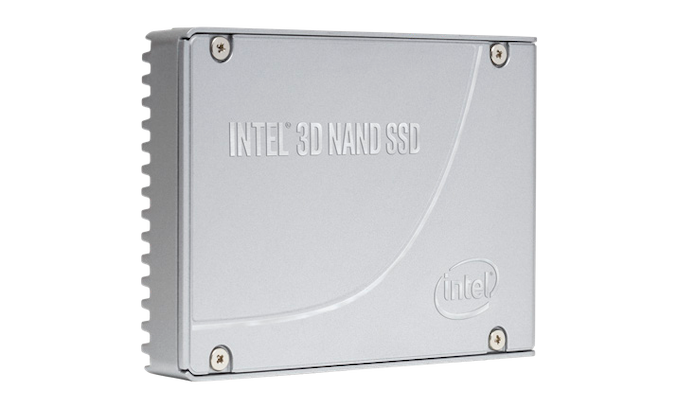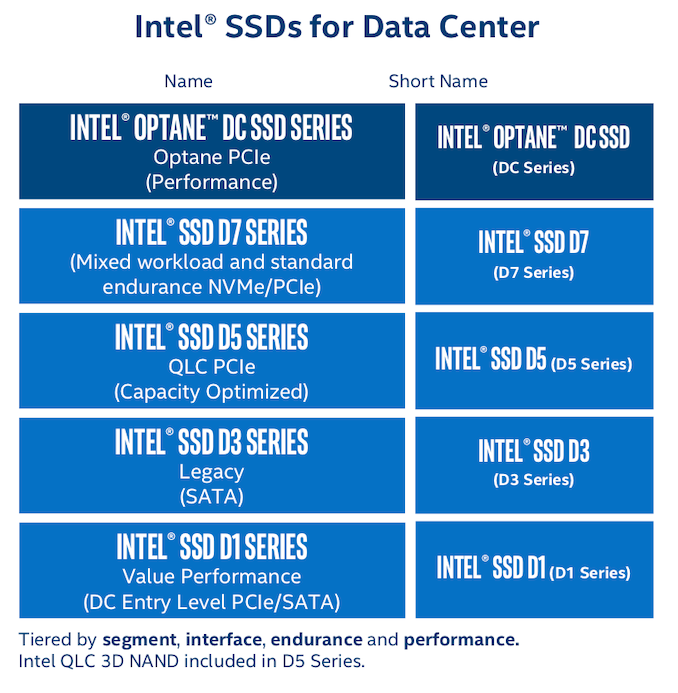Intel Announces D7-P5500 and D7-P5600 Series PCIe 4.0 Enterprise SSDs
by Billy Tallis on June 18, 2020 9:00 AM EST
Intel has yet to launch their first CPUs supporting PCIe 4.0, but other parts of the business are keeping pace with the transition: network controllers, FPGAs, and starting today, SSDs. The first PCIe 4.0 SSDs from Intel are based on their 96-layer 3D TLC NAND flash memory, slotting into Intel's product line just below Optane products and serving as Intel's top tier of flash-based SSDs. The new Intel D7-P5500 and D7-P5600 are codenamed Arbordale Plus, a codename Intel revealed last fall without providing any other information except that the original Arbordale product was never released.
The two new SSD product lines are the first to fall into the D7 tier under the new naming scheme adopted by Intel in 2018. The P5500 and P5600 are closely-related products that differ primarily in their overprovisioning ratios and consequently their usable capacities, write speed and write endurance. The P5500 is the 1 drive write per day (DWPD) lineup with capacities ranging from 1.92 TB up to 7.68 TB, while the P5600 is the 3 DWPD tier with capacities from 1.6 TB to 6.4 TB. These serve as the successors to the P4510 and P4610 Cliffdale Refresh drives, and as such we expect some follow-on models to introduce the EDSFF form factor options and QLC-based drives that are still due for an update.
| Intel PCIe 4.0 Enterprise SSDs | |||
| D7-P5500 | D7-P5600 | ||
| Form Factor | U.2 2.5" 15mm | ||
| Interface | PCIe 4.0 NVMe 1.3c | ||
| Capacities | 1.92TB, 3.84TB, 7.68TB |
1.6TB, 3.2TB, 6.4TB |
|
| NAND | Intel 96L 3D TLC | ||
| Sequential Read | 7000 MB/s | ||
| Sequential Write | 4300 MB/s | ||
| Random Read (4 kB) | 1M IOPS | ||
| Random Write (4 kB) | 130k IOPS | 260k IOPS | |
| Power | Operating | 20 W | |
| Idle | 5 W | ||
| Write Endurance | 1 DWPD | 3 DWPD | |
| Warranty | 5 years | ||
The switch to PCIe 4.0 enables a big jump in maximum throughputs supported: from 3.2 GB/s up to 7 GB/s for sequential reads, while sequential writes show a more modest increase from 3.2 GB/s to 4.3 GB/s. Random reads now hit 1M IOPS compared to about 651k IOPS from the previous generation, and random writes are still bottlenecked by the flash itself with a peak of 260k IOPS from the new P5600.
Intel hasn't shared information about the internal architecture of the new SSDs, so we don't know if they're still using a 12-channel controller design like their previous generation. Intel does tout improved QoS and a handful of new features, including a re-working of their TRIM implementation to reduce its interference with the performance of more important IO commands.











35 Comments
View All Comments
spaceship9876 - Thursday, June 18, 2020 - link
Pretty sure your power consumption figures but be wrong, uses 4x more when idle?romrunning - Thursday, June 18, 2020 - link
Yeah, those should be flipped.It's always nice when writers read comments to their articles; sometimes it can really improve the accuracy. XD
shabby - Thursday, June 18, 2020 - link
Is intel using amd hardware to test these drives?😂yeeeeman - Thursday, June 18, 2020 - link
Nope, ice lake server platform support pcie 4.0Deicidium369 - Thursday, June 18, 2020 - link
No - Intel has had PCIe4 working for quite some timeKorguz - Thursday, June 18, 2020 - link
oh ? prove it, post a link that shows this, i dare you.amnesia0287 - Thursday, June 18, 2020 - link
https://wccftech.com/intel-10nm-ice-lake-sp-xeon-c...Spunjji - Friday, June 19, 2020 - link
That shows they have them working now (which you'd hope would be the case for a Q3 launch), not necessarily for "quite some time".I'd be extremely surprised if they didn't have *some* form of PCIe 4 test platform even prior to Ice Lake SP, though.
edzieba - Friday, June 19, 2020 - link
'Launch' of a new server product is preceded by many months of small-scale usage by large customers in order to test and refine it. Cooper Lake being a recent example: in the hands of Facebook since before August 2019, but released for volume sales yesterday. That's not unusual, it;s the norm for the server products. This is why the server products have been an 'architecture behind' the consumer products.eastcoast_pete - Friday, June 19, 2020 - link
I would be surprised if they did not test those in EPYC servers also. After all, Intel will gladly sell you a bunch of expensive enterprise SSDs to run in your AMD setup, just like they sell OEMs wired and wireless networking adapters for use in AMD motherboards.